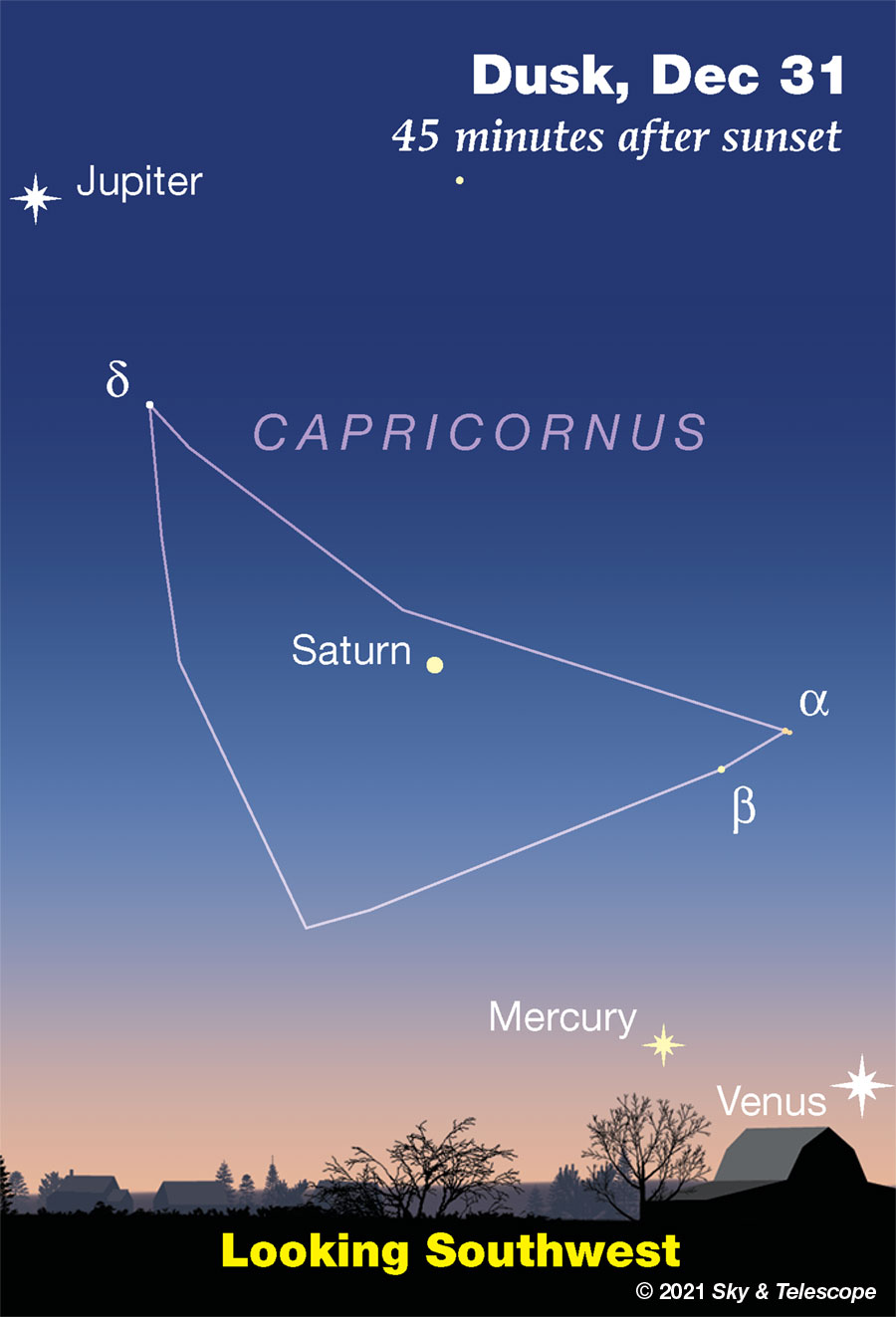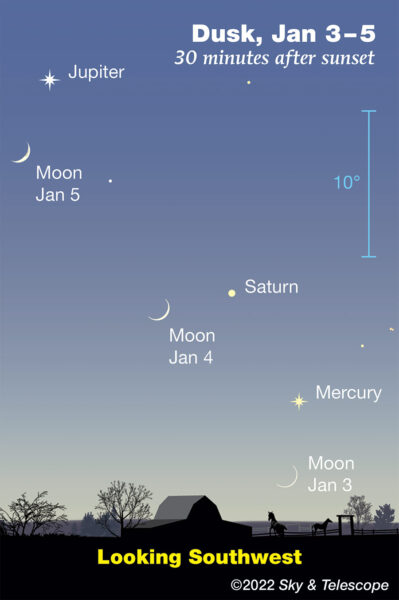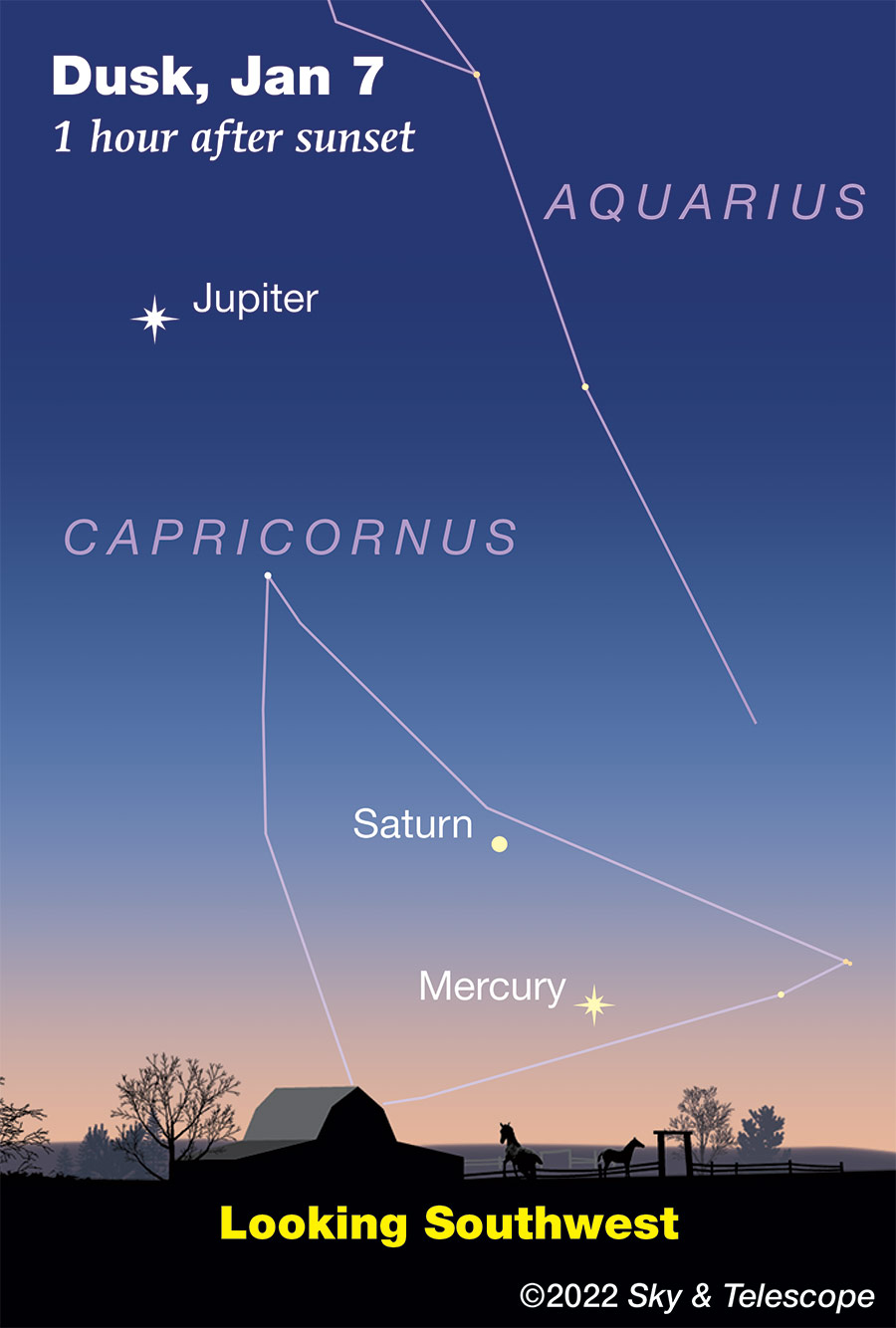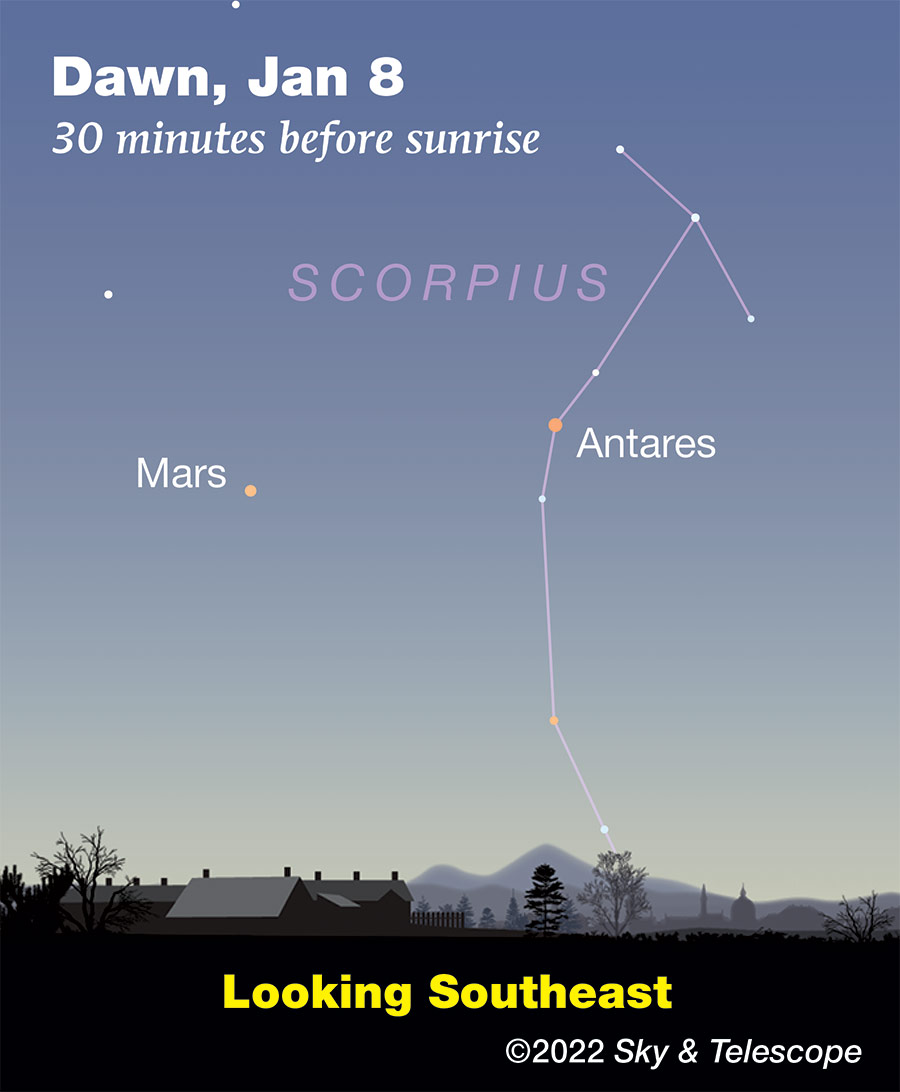As the calendar flips the a new year, the night sky brims with bright stars, planets, and a meteor shower to help you celebrate.
FRIDAY, DECEMBER 31
■ For months Jupiter, Saturn, and Venus have highlighted the evening twilight in a diagonal line. But like 2021 itself, those times are ending. Jupiter is still high in the southwest, and dimmer Saturn is still two fists to its lower right. But Venus is dropping away fast, and Mercury is taking its place.
Look for Venus this evening very low above the west-southwest horizon, far lower right of Jupiter and Saturn as shown below. Left of Venus is newly-emerged Mercury. The next few days will see Venus drop from sight while Mercury climbs toward Saturn.

■ After the noise and cheering at the turning of midnight tonight, step outside into the silent, cold dark. Shining high in the south will be Sirius, with the other stars of Canis Major to its right and below it. Sirius is the bottom star of the bright, equilateral Winter Triangle. The other two are Betelgeuse in Orion's shoulder to Sirius's upper right, and Procyon the same distance to Sirius's upper left. The Triangle stands upright, just about in balance. Happy New Year.
No Moon or planets grace the midnight sky.
SATURDAY, JANUARY 1
■ As we enter serious winter now, the bowl of the Little Dipper hangs straight down from Polaris around 8 or 9 p.m., as if from a nail on the cold north wall of the sky.
The brightest star of the Little Dipper's dim bowl is Kochab, at the bowl's lip. It's the equal of Polaris. Kochab passes precisely below Polaris around 8 p.m., depending on how far east or west you live in your time zone.
SUNDAY, JANUARY 2
■ Algol should be at minimum brightness, magnitude 3.4 instead of its usual 2.1, for a couple hours centered on 7:01 p.m. EST.
■ The Quadrantid meteor shower may or may not be active for North American observers in the hours before dawn Sunday and Monday, January 2nd and/or 3rd. The shower's strong peak typically lasts just 4 hours long or less, and it's predicted for 20:40 UT January 3rd, which is 3:40 in the afternoon Eastern Standard Time. Observers on the opposite side of the world will be the ones optimally placed.
At least the sky will be perfectly moonless, because...
■ New Moon; exact at 1:33 p.m. Eastern Standard Time.
MONDAY, JANUARY 3
■ After sunset, the thin waxing crescent Moon performs a three-step dance past three planets in three days. It did a similar thing there last month. But this time Mercury has substituted in for Venus, as shown below.
This evening, use binoculars to look for the very thin crescent well below Mercury a mere half hour or less after sunset. The farther south you live, the better your chance.

TUESDAY, JANUARY 4
■ Now the thickening crescent Moon shines to the left of far, faint Saturn, as shown above.
■ The constellation figure of Orion has only a tiny, pea-brained head: 4th-magnitude Lambda Orionis and its two fainter companions, Phi1 and Phi2. Binoculars show them well. Did you know they're part of a sparse, loose open cluster named Collinder 69? Good binoculars under a dark sky may show a dozen of its members thinly scattered over an area 1° or more across. Astronomers have identified about 100 in all. See Matt Wedel's "Head of the Hunter," his Binocular Highlight column in the January Sky & Telescope, page 43.
WEDNESDAY, JANUARY 5
■ This evening the Moon is under bright Jupiter, as shown above.
■ Sirius and Procyon in the balance. Sirius, the Dog Star, sparkles low in the east-southeast by about 7 p.m., depending on your location. Procyon, the Little Dog Star, shines in the east about two fist-widths at arm's length to Sirius's left.
But directly left? That depends. If you live around latitude 30° (Tijuana, New Orleans, Jacksonville), the two canine stars will be at the same height above your horizon soon after they rise. If you're north of that latitude, Procyon will be higher. If you're south of there, Sirius will be the higher one. Your eastern horizon tilts differently with respect to the stars depending on your latitude.
THURSDAY, JANUARY 6
■ Auriga the Charioteer rides high these evenings astride the Milky Way, awaiting your eyes and telescope. Use Ken Hewitt-White's "Suburban Stargazer" guide with its charts and descriptions in the January Sky & Telescope, page 54.
FRIDAY, JANUARY 7
■ Mercury is at greatest elongation, 19° east of the Sun.


SATURDAY, JANUARY 8
■ After dinnertime now, the enormous Andromeda-Pegasus complex runs from near the zenith way down toward the western horizon.
Just west of the zenith, spot Andromeda's high foot: 2nd-magnitude Gamma Andromedae (Almach), slightly orange. Andromeda is standing on her head. About halfway down from the zenith to the west horizon is the Great Square of Pegasus, balancing on one corner. The top corner is Andromeda's head. From the bottom corner run the stars outlining Pegasus's neck and head, ending at his nose: 2nd-magnitude Enif, due west — and also slightly orange.
This Week's Planet Roundup
Mercury and brighter Venus begin the week very low in the west-southwest in twilight on New Year's Eve, as shown at the top of this page. Mercury, magnitude –0.7, glimmers 7° left of Venus that evening. Then as January get going, Venus drops away to leave Mercury shining alone, approaching Saturn.
Mercury fades only a trace this week, to magnitude –0.5.
Venus reaches conjunction, 5° north of the Sun, on January 8th.
Mars, far and faint at magnitude +1.5, has just passed Mars-colored Antares low in early dawn. Look for them in the southeast very far below high Arcturus.
Antares is the brighter of the two orange dots down there, at magnitude +1.1. On New Year's morning, look for Mars is 6° to Antares's left. A week later Mars is 10° left or lower left of Antares, as shown above.
Mars is on the far side of its orbit from us, so in a telescope it's just a tiny blob 4 arcseconds wide.
Jupiter, magnitude –2.1 in Aquarius, shines in the southwest at dusk. Spot Fomalhaut, magnitude +1.2, some 20° to Jupiter's lower left.
Saturn, magnitude +0.7 in central Capricornus, is about the same distance lower right of Jupiter.
And the star way off to the right of Saturn and Jupiter (by 3 or 4 fists at arm's length) is Altair.
Uranus (magnitude 5.7, in Aries north of the head of Cetus) is very high in the south-southeast in early evening. See Bob King's story and finder chart.
Neptune (magnitude 7.9, in Aquarius) is high in the south-southwest after dark. It adds an invisible (to the naked-eye) planet to the Venus-Saturn-Jupiter line, 20° upper left of Jupiter.
All descriptions that relate to your horizon — including the words up, down, right, and left — are written for the world's mid-northern latitudes. Descriptions and graphics that also depend on longitude (mainly Moon positions) are for North America.
Eastern Standard Time, EST, is Universal Time (also called UT, UTC, GMT, or Z time) minus 5 hours.
Want to become a better astronomer? Learn your way around the constellations. They're the key to locating everything fainter and deeper to hunt with binoculars or a telescope.
This is an outdoor nature hobby. For an easy-to-use constellation guide covering the whole evening sky, use the big monthly map in the center of each issue of Sky & Telescope, published by the American Astronomical Society.
Once you get a telescope, to put it to good use you'll need a detailed, large-scale sky atlas (set of charts). The basic standard is the Pocket Sky Atlas (in either the original or Jumbo Edition), which shows stars to magnitude 7.6.

Next up is the larger and deeper Sky Atlas 2000.0, plotting stars to magnitude 8.5; nearly three times as many. The next up, once you know your way around, are the even larger Interstellarum atlas (stars to magnitude 9.5) or Uranometria 2000.0 (stars to magnitude 9.75). And be sure to read How to Use a Star Chart with a Telescope.
You'll also want a good deep-sky guidebook, such as the big Night Sky Observer's Guide set (2+ volumes) by Kepple and Sanner.
Can a computerized telescope replace charts? Not for beginners, I don't think, and not on mounts and tripods that are less than top-quality mechanically, meaning heavy and expensive. And as Terence Dickinson and Alan Dyer say in their Backyard Astronomer's Guide, "A full appreciation of the universe cannot come without developing the skills to find things in the sky and understanding how the sky works. This knowledge comes only by spending time under the stars with star maps in hand."
![]() Audio sky tour. Out under the evening sky with your
Audio sky tour. Out under the evening sky with your
earbuds in place, listen to Kelly Beatty's monthly
podcast tour of the heavens above. It's free.
"The dangers of not thinking clearly are much greater now than ever before. It's not that there's something new in our way of thinking, it's that credulous and confused thinking can be much more lethal in ways it was never before."
— Carl Sagan, 1996
"Facts are stubborn things."
— John Adams, 1770
 11
11









Comments
mary beth
January 1, 2022 at 1:06 pm
Happy New Year all!
He who marvels at the beauty of the world in summer will find equal cause for wonder and admiration in winter.... In winter the stars seem to have rekindled their fires, the moon achieves a fuller triumph, and the heavens wear a look of a more exalted simplicity. ~John Burroughs, "The Snow-Walkers," 1866
You must be logged in to post a comment.
Anthony Barreiro
January 1, 2022 at 6:55 pm
Thank you Mary Beth. Happy Gregorian New Year!
You must be logged in to post a comment.
Rod
January 2, 2022 at 9:37 am
Very good Anthony 🙂 The Gregorian calendar is used in the 7 Articles of the US Constitution too, including the Declaration of Independence. However, we could always go back to celebrating Akitu, the Babylonian New Year and read from the ancient 7 tablets of creation as the ancient King did 🙂
You must be logged in to post a comment.
mary beth
January 2, 2022 at 2:59 pm
Excellent information Rod, thank ! i’m looking this up now, I think we should celebrate this as well! Get your barley ready!!
You must be logged in to post a comment.
mary beth
January 2, 2022 at 2:55 pm
Happy New Year to you Anthony! Should we also celebrate Julian on the 14th? There will be an awesome gibbous moon in the stellar company of Capella, Aldebaran and Betelgeuse to light our way!
Also here’s another nice little passage that I bet you will appreciate:
Janus am I; oldest of potentates;
Forward I look, and backward, and below
I count, as god of avenues and gates,
The years that through my portals come and go.
-Henry Wadsworth Longfellow (1807-82)
You must be logged in to post a comment.
Anthony Barreiro
January 2, 2022 at 5:39 pm
Sure, let's celebrate Julian new year too, why not? Any excuse for a fresh start!
In response to Janus:
“Don’t look back -- something might be gaining on you.” -- Satchel Paige.
You must be logged in to post a comment.
Rod
January 3, 2022 at 11:40 pm
I was able to get out tonight under the stars after the snow fall today. Observed 2130-2230 EST/0230-0330 UT. I used 10x50 binoculars this evening for stargazing. Targets I focused on, M35, M37, M45, Aldebaran, M42, M41, NGC 2362. More than 8 inches of fresh snow covered the fields, so I did not take out my telescopes. Enjoyable binocular views of M35, I could see with unaided eyes too. M37 in Auriga, Aldebaran in Taurus. In the 10x50 binocular view, Sigma1, Sigma2, Theta1 and Theta2 Tauri stars with others visible in the star pattern around Aldebaran. A lovely color contrast here using the binoculars. M42 a very nebulous appearance tonight. M42 is great viewing using my telescopes. I could see M41 in Canis Major unaided eyes and binocular view good. NGC 2362 in Canis Major open cluster viewed. This open cluster is best seen using my 90-mm refractor telescope or 10-inch Newtonian. The fields were covered with snow. Shortly after sunset, the snow landscape all around with clear sky looked like scenes from the movie, The Day After Tomorrow 🙂 Temperature when I was out -6C going down to -9C or -10C. A lovely winter night out under the stars and so quiet all around. The wood burning stove was running, always good to come back inside from winter stargazing nights and sit by the fire .
You must be logged in to post a comment.
Rod
January 4, 2022 at 8:11 am
I checked a bit more. Looks like I had about 12 inches of snow, other farms nearby reported 14 inches. This morning news, Cape May NJ had 7 to 8 inches of snow and temperature -7C this morning. New Jersey Eclipse Fan, looks like folks in your area should be flocking to the beaches today 🙂 In VA, some vehicles were stuck on the highways for more than 12 hours so that was bad. Perhaps tonight I will use my telescopes but on the paved areas around the house that are cleared.
You must be logged in to post a comment.
mary beth
January 4, 2022 at 3:15 pm
Wow! As a Southern girl, that sounds fun to me but I’m sure people who live there don’t really like it. But I’m sure everyone can appreciate the beauty! I’m glad you were able to get out Rod, sounds like you had a really nice time. Lucky me: I was able to see a lot of night sky objects the last couple of days! After 10 days of clouds, we finally had a beautiful clear night on January 2. I took the dogs out about 11:30 PM and the (very low humidity) sky was full of stars. I live by the airport. I actually thought Canopus was an airplane coming into land from the south. When I realized what it was I was thrilled! It took me a few minutes to get my bearings, then I realized overhead was bright and beautiful Capella and Aldebaran with the Gemini Twins nearby. Of course Orion was shining brightly in the south/southeast. I was able to see more stars than usual in Canis Major, a real treat. Then yesterday evening I was fortunate to be able to see the very Young crescent moon low in the southwest sky, and I was also blessed to see Mercury. I got a couple of good pictures. If it’s clear tonight I’ll ask all my neighbors to come and view. Hope everyone has a great start to the new year and lots of clear skies ahead!
You must be logged in to post a comment.
mary beth
January 6, 2022 at 7:05 pm
Happy Birthday Johannes Kepler!! 6th January 1572
You must be logged in to post a comment.
mary beth
January 6, 2022 at 8:44 pm
Anthony….I was wondering if you can read between the lines on this one! Something very specific about 1572
You must be logged in to post a comment.
You must be logged in to post a comment.